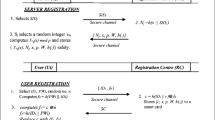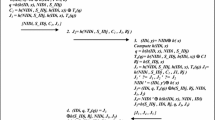Abstract
Multi-server authentication (MSA) enables the user to avail multiple services permitted from various servers out of a single registration through registration centre. Earlier, through single-server authentication, a user had to register all servers individually for availing the respective services. In the last few years, many MSA-based schemes have been presented; however, most of these suffer communication overhead cost due to the Registration Centre (RC) involvement in every mutual authentication session. In voice communication this round-trip latency becomes even more noticeable. Hence, the focus of the protocols design has been shifted towards light-weight cryptographic techniques such as Chebyshev chaotic map technique (CCM). We have reviewed few latest MSA-related schemes based on CCM and elliptic curve cryptography (ECC) as well. Based on these limitations and considerations, we have proposed a single-round trip MSA protocol based on CCM technique that foregoes the RC involvement during mutual authentication. Our study work is cost efficient in terms of communication delay and computation, and provides enhanced security by the use of public key cryptosystem. The proposed scheme is duly backed by formal security analysis and performance evaluation.

Similar content being viewed by others
References
Lamport L (1981) Password authentication with insecure communication. Commun ACM 24(11):770–772
Lee NY, Chiu YC (2005) Improved remote authentication scheme with smart card. Comput Stand Interfaces 27(2):177–180
Sun HM (2000) An efficient remote use authentication scheme using smart cards. IEEE Trans Consum Electron 46(4):958–961
Lin CH, Lai YY (2004) A flexible biometrics remote user authentication scheme. Comput Stand Interfaces 27(1):19–23
Khan MK, Zhang J (2007) Improving the security of a flexible biometrics remote user authentication scheme. Comput Stand Interfaces 29(1):82–85
Li LH, Lin IC, Hwang MS (2001) A remote password authentication scheme for multi-server architecture using neural networks. IEEE Trans Neural Netw 12(6):1498–1504
Lin IC, Hwang MS, Li LH (2003) A new remote user authentication scheme for multi-server architecture. Future Gener Comput Syst 19(1):13–22
Tsai JL (2008) Efficient multi-server authentication scheme based on one-way hash function without verification table. Comput Secur 27(3–4):115–121
Shen H et al (2015) New biometrics-based authentication scheme for multi-server environment in critical systems. J Ambient Intell Humaniz Comput 6(6):825–834. doi:10.1007/s12652-015-0305-8
Tsai Jia L, Nai WL (2014) A chaotic map based anonymous multi-server authenticated key agreement protocol using smart card. Int J Commun Syst 28(13). doi:10.1002/dac.2829
Jiang P et al (2015) An anonymous and efficient remote biometrics user authentication scheme in a multi server environment. Front Comput Sci 9(1):142–156. doi:10.1007/s11704-014-3125-7
Zhu H (2015) A provable one-way authentication key agreement scheme with user anonymity for multi-server environment. KSII Trans Internet Inf Syst 9(2):811–829. doi:10.3837/tiis.2015.02.19
Ravi SP, Jaidhar CD, Shashikala T (2013) Robust smart card authentication scheme for multiserver architecture. Wirel Pers Commun 72:729–745. doi:10.1007/s11277-013-1039-6
Zhang L (2008) Cryptanalysis of the public key encryption based on multiple chaotic systems. Chaos Solitons Fractals 37(3):669–674
Yoon E-J, Yoo K-Y (2013) Robust biometrics-based multi-server authentication with key agreement scheme for smart cards on elliptic curve cryptosystem. J Supercomput 63:235–255
Liao YP, Wang SS (2009) A secure dynamic ID based remote user authentication scheme for multi-server environment. Comput Stand Interfaces 31(1):24–29
Wen FT, Li XL (2011) An improved dynamic ID-based remote user authentication with key agreement scheme. Comput Electr Eng 38(2):381–387
Hsiang HC, Shih WK (2009) Improvement of the secure dynamic ID based remote user authentication scheme for multi-server environment. Comput Stand Interfaces 31(6):1118–1123
Lee CC, Lin TH, Chang RX (2011) A secure dynamic ID based remote user authentication scheme for multi-server environment using smart cards. Expert Syst Appl 38(11):13863–13870
Guo DL, Wen FT (2014) Analysis and improvement of a robust smart card based-authentication scheme for multi-server architecture. Wirel Pers Commun 78(1):475–490
Wen FT, Susilo W, Yang GM (2013) A robust smart card based anonymous user authentication protocol for wireless communications. Secur Commun Netw 7(6):987–993
Sood SK, Sarje AK, Singh K (2011) A secure dynamic identity based authentication protocol for multi-server architecture. J Netw Comput Appl 34(2):609–618
Li X, Xiong YP, Ma J, Wang WD (2012) An efficient and security dynamic identity based authentication protocol for multi-server architecture using smart cards. J Netw Comput Appl 35(2):763–769
Xue KP, Hong PL, Ma CS (2014) A lightweight dynamic pseudonym identity based authentication and key agreement protocol without verification tables for multi-server architecture. J Comput Syst Sci 80(1):195–206
Khan MK, Zhang J (2007) Improving the security of a flexible biometrics remote user authentication scheme. Comput Stand Interfaces 29(1):82–85
Kim HS, Lee JK, Yoo KY (2003) ID-based password authentication scheme using smart cards and fingerprints. ACM SIGOPS Oper Syst Rev 37(4):32–41
Lee JK, Ryu SR, Yoo KY (2002) Fingerprint-based remote user authentication scheme using smart cards. Electron Lett 38(12):554–555
Chuang MC, Chen MC (2014) An anonymous multi-server authenticated key agreement scheme based on trust computing using smart cards and biometrics. Expert Syst Appl 41(4):1411–1418
Lin H, Fengtong W, Chunxia D (2015) An improved anonymous multi-server authenticated key agreement scheme using smart cards and biometrics. Wirel Pers Commun 84:2351–2362
Masuda N, Aihara K (2002) Cryptosystems with discretized chaotic maps. IEEE Trans Circuits Syst 49:28–40
Kocarev L, Lian S (2011) Chaos-based cryptography: theory, algorithms and applications. Springer, Berlin
Koblitz N (1987) Elliptic curve cryptosystems. Math Comp 48:203–209
Bellare M (1999) Practice-oriented provable security. In: Lectures on data security. Lecture notes in computer science, vol 1561. Springer, Berlin, pp 1–15
Behnia S, Akhshani A, Ahadpour S, Mahmodi H, Akhavan A (2007) A fast chaotic encryption scheme based on piecewise nonlinear chaotic maps. Phys Lett A 366:391–396
Baptista MS (1998) Cryptography with chaos. Phys Lett A 240:50–54
Xiao D, Liao X, Wong K (2005) An efficient entire chaos-based scheme for deniable authentication. Chaos Solitons Fractals 23:1327–1331
Khan M, Shah T, Mahmood H, Gondal M (2013) An efficient method for the construction of block cipher with multi-chaotic systems. Nonlinear Dyn 71:489–492
Han S (2008) Security of a key agreement protocol based on chaotic maps. Chaos Solitons Fractals 38:764–768
Xiang T, Wong K, Liao X (2009) On the security of a novel key agreement protocol based on chaotic maps. Chaos Solitons Fractals 40:672–675
Guo X, Zhang J (2010) Secure group key agreement protocol based on chaotic Hash. Inf Sci 180:4069–4074
Yoon E, Jeon I (2011) An efficient and secure Diffie-Hellman key agreement protocol based on Chebyshev chaotic map. Commun Nonlinear Sci Numer Simul 16:2383–2389
Lai H, Xiao J, Li L, Yang Y (2012) Applying semigroup property of enhanced Chebyshev polynomials to anonymous authentication protocol. Math Probl Eng. doi:10.1155/2012/454823
Stolbbnunov A (2009) Reductionist security arguments for public-key cryptographic schemes based on group action. In: The Norwegian information security conference (NISK), pp 97–109
Wang B, Ma M (2012) A smart card based efficient and secured multi-server authentication scheme. Wirel Pers Commun. doi:10.1007/s11277-011-0456-7
Xiao D, Shih F, Liao X (2010) A chaos-based hash function with both modification detection and localization capabilities. Commun Nonlinear Sci Numer Simul 15:2254–2261
Hsieh W, Leu J (2012) Anonymous authentication protocol based on elliptic curve Diffie-Hellman for wireless access networks. Wirel Commun Mobile Comput. doi:10.1002/wcm.2252
Author information
Authors and Affiliations
Corresponding author
Rights and permissions
About this article
Cite this article
Irshad, A., Sher, M., Chaudhary, S.A. et al. An efficient and anonymous multi-server authenticated key agreement based on chaotic map without engaging Registration Centre. J Supercomput 72, 1623–1644 (2016). https://doi.org/10.1007/s11227-016-1688-9
Published:
Issue Date:
DOI: https://doi.org/10.1007/s11227-016-1688-9




